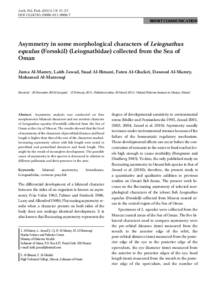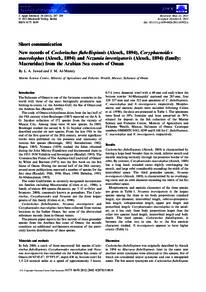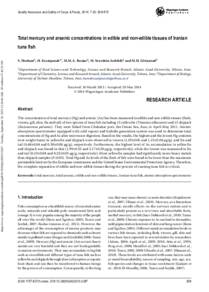Document
Validation of the synonymy of the teleost blenniid fish species Salarias phantasticus Boulenger 1897 and Salarias anomalus Regan 1905 with Ecsenius pulcher (Murray 1887) based on DNA barcoding and morphology.
Identifier
DOI: 10.11646/zootaxa.4072.2.2
Contributors
Estekani, Sanaz., Author
Springer, Victor G., Author
Crimmen, Oliver., Author
Johnson, G. David., Author
Baldwin, Carole C., Author
Publisher
Magnolia Press.
Gregorian
2016-01
Language
English
English abstract
As currently recognized, Ecsenius pulcher includes Salarias pulcher (type material has a banded color pattern), S. anomalus (non-banded), and S. phantasticus (banded). The color patterns are not sex linked, and no other morphological features apparently distinguish the three nominal species. The recent collection of banded and non-banded specimens of Ecsenius pulcher from Iran has provided the first tissue samples for genetic analyses. Here we review the taxonomic history of E. pulcher and its included synonyms and genetically analyze tissue samples of both color patterns. Salarias anomalus is retained as a synonym of E. pulcher because DNA barcode data suggest that they represent banded and non-banded color morphs of a single species. Furthermore, the large size of the largest type specimen of S. anomalus (herein designated as the lectotype) suggests that it belongs to E. pulcher. A single non-banded specimen from Iran is genetically distinct from E. pulcher and appears to represent an undescribed species. Salarias phantasticus is retained as a synonym of E. pulcher because the primary morphological difference between the two nominal species-presence of spots on the dorsal fin in E. pulcher and absence of those spots in S. phantasticus-is not a valid taxonomic character; rather, the spots represent galls that contain the larval stages of a parasitic crustacean. As males and females of Ecsenius species have been confused in the literature, we describe and illustrate the genital regions of both and comment on possible new blenniid synapomorphies that our investigation revealed.
Member of
ISSN
1175-5326
Resource URL
Category
Journal articles





